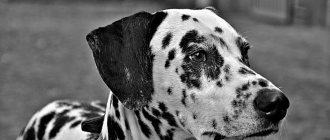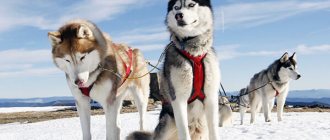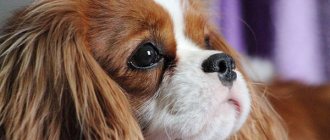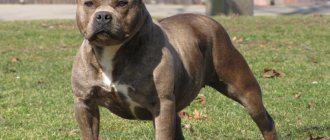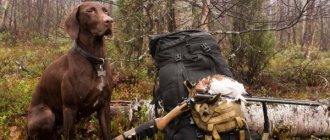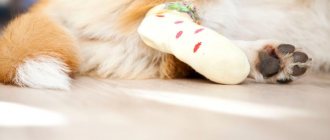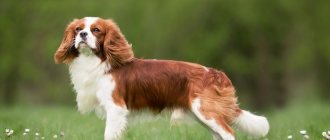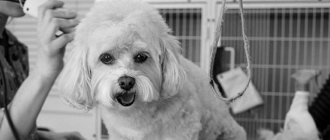Akita Inu is one of the most beautiful and smartest dogs native to Japan.
The breed is considered quite large, can reach a height of up to 70 cm, weighing up to 45 kg.
Akita was originally considered a hunting dog, but now it is a loyal friend and companion, a nanny for children and simply a charming “plush” family member.
However, the dog has not lost its hunting instincts, which is important to consider when training with your pet.
Let's look at the main points on teaching and training this wonderful breed in this article.
What to pay attention to in training
Representatives of the ancient Japanese breed are smart but stubborn dogs.
They do not obey the first requirement and consider training a useless exercise. Only respect for the owner makes the dog obey. Before training, consider several points:
- Akita Inu training is based on praise. Punishments are excluded and prohibited. Raising your voice, pulling back on the collar or leash causes distrust, refusal to obey, and lack of reaction to the nickname. Point out bad behavior with a rather displeased intonation, leaving without a treat;
- The dog is easily distracted. If music starts playing, a cat runs by, a person passes by, the animal will switch its attention from training. There is no need to get angry at a puppy or an adult dog. Let your pet satisfy its natural curiosity, then you can continue the activity;
- The owner needs to be a leader. The dog should see him as a leader who is respected for justice, calmness, and love. Intimidation and demands to obey by any means cannot achieve an obedient attitude;
- It is better to teach him commands during a walk between feedings. It is difficult to train a well-fed pet with tasty food; hunger will become a stimulus. The treat is given immediately after the correct execution of the command. Hard cheese, dried meat, and store-bought food are good options. Portions should be small;
- The dog must carry out the new command immediately. If the animal does not comply, no treat is given. Then they move on to practicing another action;
- Aggression towards other people or animals is stopped immediately, but without punishment. The dog will not tolerate such an attitude towards himself. It's better not to pay attention for a while;
- Living conditions in a private house or spacious apartment are important. They communicate a lot with dogs of this breed, walking at least 3 hours a day. Early socialization is important for puppies to teach them commands in different situations. Older dogs should wear a muzzle when walking in crowded places.
- Classes with a dog handler are recommended. It is difficult for an inexperienced dog breeder to train this breed; such courses are necessary for him.
Akita Inu are independent, proud, intelligent animals. Puppies begin to be raised from the first days of their arrival in the family, and real training is successful only with mutual respect with the person.
Take the Attention Test! Find 10 differences! (click right here!)
Find the answer Are you bothered by some problem or question? Enter “Breed” or “Name of the problem” into the form, press Enter and you will find out everything about the issue that interests you.
Where to start?
Before you begin a training program for an Akita puppy , you need to establish trusting contact with him.
The owner will spend the first few days studying the character and individual traits of the dog, its initial skills, habits and preferences, and also, possibly, coming up with a nickname.
Next, the dogs need to be socialized, and the sooner the better. If there are children in the family, then you should immediately introduce the pet to them. As a rule, this will not be a problem - the Akita reacts well to children and even shows care and attention to them.
As early as possible, you should start taking your puppy for walks with other dogs, especially males, because... in the future they may be prone to aggression towards other four-legged animals.
First, you need to accustom your pet to a leash in order to limit its independence and autonomy to a certain distance, and then gradually begin training, starting with play forms.
By drawing conclusions about the characteristics of your dog and the peculiarities of its behavior, a training program is developed based on friendly relations and a reward system .
Owner experience
Do not train your baby if you are in a bad mood, dogs are excellent psychologists, and your depression can rub off on them. Both puppies and adults copy their owner in everything; a loving dog will try to be with you.
Dogs are able to find a special approach to everyone in order to satisfy their whims. There are no two identical puppies or adult pets; each has a different character and habits.
His character in the future depends on training. It depends on you whether your pet will grow up to be a cheerful and devoted friend or a nervous, unsociable creature.
At what age should you start?
There is still an opinion that it makes sense to start training after the dog reaches the age of 6 months. In relation to Akitas, this opinion is incorrect.
Akita Inu puppies are distinguished by high intelligence and willful character. As soon as a small pet enters your home, it already shows its character and tries to take the place of leader. Therefore, it is worth starting to raise a puppy from the first days, and full training at the age of 3-4 months.
Expert opinion
Kozhevin Semyon Kirillovich
Expert dog handler.
Of course, compared to shepherds and Rottweilers, training the Akita Inu breed, if you decide to do it yourself, requires more effort, patience, and affection from you. Akitas are devoted and faithful to their owners, but are not always ready to obey any commands without a reason. It is important to start socializing the puppy as early as possible, even try to let him out without a leash, while constantly calling him to you. Remember, any method of training this breed should be based on affection and praise after a successfully executed command, so the pet will understand what is right and wrong in its behavior.
Why train
Training a dog at home has 3 goals:
- The pet must recognize the owner as a leader.
- The person will know well how to behave with the pet.
- A trained dog is a socially adapted pet.
The owner must choose whether to use deterrents or rewards for a motivational item.
The greatest impact is achieved when the dog receives praise right away.
Containment methods:
- Using objects that can attract the dog's attention. Things that make sharp sounds - whistles, a bunch of keys, a rattle from a tin can with pebbles, etc.
- If the actions are not followed, the dog loses the owner's attention. She is sent to her place without the usual stroking and praise, in a stern voice.
Pet restraint methods can be used on older puppies older than 4 months. If the dog is unbalanced, then this method should not be used.
Ignoring a pet is a more effective technique than physical influence.
Training is quite a labor-intensive task, but teaching a dog to behave correctly is easier than correcting inappropriate behavior.
Is it possible to train guard duty?
Quite often, given the size of the dog, owners expect it to be a good guard. However, the Akita is not a guard dog. Representatives of the Akita Inu breed are truly ready to fight with any living creature in order to protect their owner. But first of all, it is a hunting dog.
If you begin to actively train an Akita to guard and attack, the dog may begin to attack all unfamiliar people approaching the house.
The owner’s task is to teach the dog to vocalize when it sees a stranger. Teaching should be done through examples and simulated situations. It is best for the Akita to observe the behavior of another adult dog when it sees a stranger.
For a novice trainer
To prevent training from turning into torture:
- Take your pet for a walk beforehand. A tired, running dog is less distracted. The effect will be greater. Active walking makes working with the animal easier.
- The command is spoken once.
- Take pauses. When practicing, for example, “near”, “lie down”, “fetch”, you need to give the dog time to take a breath. 5-10 seconds will be enough.
- Change the sequence. If the dog gets used to doing everything in order. That, for example, after “to me” you need to “sit.”
- You can't overload it. Too intense training can harm the animal.
An already trained dog follows commands under any conditions. But your pet may get tired.
- Sometimes students, like ordinary schoolchildren, “run away from class.” They may be distracted by a nearby cat or other animal. Be more careful with your exposure. Train her on a long leash. This will allow you to catch up with the “mischievous person”, even if he runs fast. A leash with a carabiner for 3-5 meters is suitable. Often such a leash is just needed for endurance and training to pick up “goodies” from the floor.
- “Mass” training is not allowed. Only the owner should act as a trainer. Otherwise the dog will be distracted.
- It's worth pausing. If the animal doubts the correctness of the actions, the reason is the load. Give your dog a simple command and then praise generously. When she sees that the owner approves of him, she will begin to perform the exercises better. Play or take a walk with her.
- Commands are studied systematically and gradually. You need to train your pet to obey in any conditions. Start in a quiet place, gradually adding more “stimulants.” Create them. For example, scatter treats, call a friend to pass by the training place.
To train an animal, you need to be patient and perform the exercises systematically.
What can be taught?
By correctly and consistently carrying out all the steps to raise and train a pet, an Akita dog can be taught everything that other trained dogs can do.
First of all, the puppy must be accustomed to the important components of life with a person :
- use a diaper to relieve yourself;
- do not bite a person;
- do not be afraid of the collar and leash;
- do not beg for food from the owner’s table or pick it up from the floor;
- treat strangers with respect;
- stop barking on the owner's command;
- follow basic commands “sit”, “stand”, “lie down”;
- understand the command “fu”;
- execute the "nearby" command.
NOTE!
Learning certain behaviors and commands occurs gradually; you cannot throw everything at once onto the puppy’s fragile psyche and body.
General training course
The general training course is based on systematic training. The skills developed during the general course form the basis for the formation of conditioned reflexes in the animal.
The first skill is to teach the puppy to go to the toilet only outside. During the learning process, it is necessary to practice instructions with gestures and voice.
General skills and abilities include:
- Response to nickname;
- Habit of a collar, leash, harness;
- Approach to the trainer;
- Walking nearby;
- Habit of lying, sitting, standing, crawling positions;
- Ability to follow voice commands, stop certain actions, overcome obstacles;
- Refusal of other people's food;
- Tolerance to noise stimuli.
Socialization of an Akita Inu puppy at 3 months
Three months is an important stage in introducing an Akita Inu puppy to the outside world. Your first walks should be short and not too tiring for the puppy.
At this age, the puppy’s nervous system is forming.
, so it is necessary to show him as much as possible: noisy streets, large crowds of people, etc. This must be done very carefully, gradually, over and over again increasing the time spent in noisy places, so as not to overload the puppy and not frighten him.
It is also necessary to introduce the puppy to friendly dogs and people.
so that later the puppy does not develop aggression or cowardice caused by the fear of new things and the inability to communicate and make new acquaintances. And this is currently, unfortunately, not uncommon in the behavior of adult dogs, but a fairly common problem with which people turn to our specialists for help.
The emergence of new places leads to new rules that need to be consolidated:
- Now you can and should go to the toilet on the street, rather than steadfastly endure and carry everything home;
- Not every new person or dog wants to communicate, so you don’t need to run headlong to meet everyone;
- Not all food is healthy, so it should only be taken from the owner’s hands.
Training a puppy follows the same principles as at 2 months. It should be remembered that at this age puppies develop conditioned reflexes quite easily, but they are also quickly forgotten, so you should not scold the puppy for not following commands, especially if they have not been repeated for a long time, but you should pay more attention to learning new things and repeating already learned material .
General principles of animal training
To successfully train a pet, systematic training is necessary. The duration of the lesson should not exceed 2 hours. Commands for dogs: the list of techniques practiced in the lesson depends on the level of training of the animal; for example, a Labrador puppy begins to be trained from the first months. Gradually the number of teams should be increased.
https://dog-care.ru/dressirovka/obuchenie/kak-dressirovat-akita-inu.html
New techniques are practiced in the first part of the lesson. After each command, a three-minute break is required for the pet.
Rules for successfully training a puppy:
- Techniques performed correctly should be reinforced with praise and encouragement.
- It is better to voice the instruction once, accompanied by a gesture.
- Maintaining consistency in orders and gestures.
- The first classes are conducted in a familiar environment, then change the environment.
- The trainer and the dog are in a good mood.
- It is better to end the lesson with an instruction that the puppy does better than others.
Appearance and special features of the breed
The Japanese version is called Akita Inu - these are medium to large sized dogs with a dense, at the same time graceful physique. The head with small ears resembles a fox. Only a few color options are recognized. The fur must be short and there must be a white mask on the muzzle.
The version from the USA is called the large Japanese dog or American Akita. They are exceptionally large dogs with heavy bear-like heads. Almost any variant of suit is recognized, including black or with a dark mask.
general description
Akita Inu thrives in moderate to cold climates. Among the characteristic features:
- fairly large head;
- erect triangular ears;
- strong physique;
- tail curled into a donut.
An adult male has a height of 66-71 cm at the withers, weight from 45 to 59 kg. Females are 61-66 cm tall, weigh from 32 to 45 kg, while their body length is slightly longer than that of males. The Japanese version of the breed is slightly lighter and smaller. Eight-week-old puppies usually have the following parameters:
- large Japanese - weight 8.16-9.97 kg;
- Akita Inu – weight 7.25-9.07 kg.
The growth of dogs is slow; the animal’s development finally ends only by 3 years. Puppies gain weight quite actively (up to 7 kg per month); after reaching 35-49 kg, their development slows down greatly, but does not complete until the age of three. Don't worry if your pet doesn't quite fit into existing growth charts as these are very general guidelines. In general, the dynamics are as follows:
- 6 weeks – the puppies are large and very charming, little like adult dogs;
- 6 months – body proportions change, the dog becomes more toned, the puppy roundness disappears, characteristic features are more clearly defined;
- 1 year – bitches begin to heat, but they cannot be considered adults;
- 1-2 years – the growth process slows down greatly, but the transformation of the body continues, especially in the head area;
- 2 years – the dog stops growing in height, expands slightly in width, small changes will continue for another year.
Wool
The classic standard is a dense short coat (about 5 cm), which is slightly longer on the neck and tail. The coat is erect, made of coarse guard and needle-like hairs, the undercoat is very thick and downy. Akita Inu can only have this color:
- pure white;
- red with white fragments and mask (urajiro);
- brindle, also with urajiro;
- red with black tips of hairs (sesame).
The American Akita comes in any color. Long-haired dogs are often born - this is a consequence of a combination of recessive genes from the father and mother. They are the same in character, but do not fit into the standard, therefore they are considered a reject.
Ears
In puppies, the ears are drooping, while in adult dogs they are erect, facing forward and slightly to the sides. They do not accept this position immediately, and this is influenced by two factors:
- age - only as you grow older and strengthen the special muscles, the ears will begin to rise. Chewing and gnawing on toys can speed up this process;
- change of teeth - until permanent teeth appear in place of milk teeth, the ears will not rise completely.
It often happens that they fall back or only one ear is erect. This process takes from 10 weeks to 6 months, so there is no need to worry until six months - the position of the ears will level out.
Eyes
The eyes are brown (preferably as dark as possible), small, deep-set. They have a triangular "oriental" shape that is noticeable from birth. For dogs of light color, black “eyeliner” is allowed, which only emphasizes the special cut.
Tail
In purebred dogs it is fluffy, thick, and rolled into a tight ring. Babies have a straight tail that curls during the first 2 months of life. If the dog is sleeping or just relaxed, it may unwind slightly, but it never becomes straight. Visually and to the touch, this part of the body does not change even during the molting period. The fluffy “donut” tail seems to balance the pet’s large head.
Paws
The description of the paws differs little for different standards: straight, arched, with thick pads, similar to a cat's. Both varieties of Akita have tightly closed toes, which gives them the ability to swim well. In this case, not only the forelimbs are involved, but also the hind limbs. However, most dogs of this breed do not like to swim, entering the water only when absolutely necessary.
Release command
The instruction “Walk” (“Walk” or “Fri”) is a release for dogs that serve in the search and protective guard service.
A professionally working dog, when he is outside the apartment or outside the enclosure, is in a state of “at work”. He rests according to the instructions “Lie down” or “Place”.
If you release your pet with the word “Go for a walk,” then no training is required, the dog will remember it at the same time.
Command your pet to “Sit”, and then release it, joyfully saying “Walk!” If he doesn’t move, then you can, repeating “Walk, walk,” pat her a little, clap your hands, or run forward.
Take breaks every 15-20 minutes.
Leadership Installation
Akita Inu is almost a wolf. When communicating with a dog, you need to be able to maintain leadership and follow the laws of the pack. You need to love her unambiguously, but at the same time avoid contradictions in your behavior.
In order for the dog to feel the leader in the owner and strictly obey him, you should immediately set priorities:
- the dog eats after all family members have eaten;
- The owner must enter and exit any room ahead of the dog;
- the dog must know his place and sleep only on it - the owner’s bed is taboo for him;
- in order to position oneself as a leader, any game with a dog should only be started and finished by its owner;
- avoid signs of aggression on the part of the animal (even seemingly harmless biting).
"Place" indication
Command “Place” and entice him with a treat. On the lounger, praise and give a piece.
Gradually increase the time between arrival and reward, and then give treats occasionally. In everyday life, the “Place” command is used when a pet behaves badly (for example, begging from the table or jumping on guests).
By giving the "Place" command, you tell the dog exactly where he needs to go. They quickly grasp the meaning of this command and leave offended.
If he pesters you, then you need to command “Place” again in a more menacing tone.
Before teaching the “Place” command, make sure that the dog knows the “Lie” and “Come” commands.
Step 1: Place him on a long leash and make him lie down.
Step 2. Place a large item, such as a backpack, next to it. Do not use someone else's things or his things (muzzle, toy or bowl).
Step 3. Repeat the “Down” command to him and move away 5 steps.
Step 4: Wait 3 seconds and then command “Come.” When he approaches you, praise him.
Step 5. Give the “Place” command by pointing your hand at the backpack. Move towards the thing, but don't pull on the leash. As you walk, joyfully repeat: “Place. Place".
Step 6. Once in place, command “Down” and give a treat.
Repeat the exercise. Get him to go to the place without your help. Gradually increase the distance and stop using the leash.
The pet must approach the thing lying 15 meters away, lie down and wait (30 seconds) for you to allow it to leave the position. Teach him to stay still when people or animals walk nearby.
If the dog breaks away without a command, bring it back, repeating: “Place.” If the dog refuses to return to its place without you: call the dog left near the thing, sit it next to you and command “Wait.” Then show the dog the treat and go to the “spot” alone. Place it on your backpack and return to the dog. Command “Place”, and if the dog runs up to the thing and lies down, praise it and let it eat a piece.
What to encourage?
Before you start training, you need to prepare incentives.
Reinforcement will be a treat for your pet, which can be finely chopped pieces of food that the dog likes but does not eat regularly. For example, pieces of cheese, cooked or raw meat (chicken breast, beef, liver).
The younger the dog is, the smaller the size of the piece should be, but no more than 1-1.5 cm, so that the pet is not distracted from chewing food.
Common mistakes when training
- The dog is unconscious of its actions and does not understand human speech. When giving a command, you cannot talk; conditioned reflexes are inhibited. All commands are pronounced without further ado.
- Violations of the order of skill development. From simple to complex. Until the dog has mastered a certain command well, you cannot proceed to the next one.
- The dog handler does not take into account the characteristics of the animal, which reduces the effectiveness of training.
- Retraining. Frequently practicing the same skills helps to fatigue, reduce performance and overload the nervous system. Once the technique is learned, it is no longer performed that day. If she refuses to perform a skill as a result of overtraining, then she is given a rest for 2-3 weeks. Dog handlers monitor the condition of the dog during training.
- Incorrect voice intonation changes the sound of the command. You cannot pronounce everything in one intonation, otherwise it loses its significance as an irritant. The dog will stop responding to her.
- Incorrect use of directions. You can’t repeat it often, otherwise you’ll develop the skill of doing it when you repeat it.
Basic Rules
When training your pet of this breed, adhere to the following rules:
- first, become a friend of your Akita, gain his trust;
- do not threaten, shout or hit the dog during training;
- conduct training in a playful way to interest the dog;
- try to conduct training before lunch, the feeling of approaching hunger will give the dog an incentive to follow commands in order to receive a treat;
- reward completed commands with treats and affection;
- do not punish your pet, a proud Akita will not forgive you for this - to express dissatisfaction with his actions, simply deprive him of attention for a while;
- if you feel that the dog is tired, do not continue the lesson, give it a rest, especially in puppyhood;
- end the training with a command performed well by the puppy, this way you will secure a leadership position.
CAREFULLY!
It is forbidden to train representatives of this breed to attack people, otherwise the pet will develop a sense of superiority, it will get out of control and become potentially dangerous and aggressive.
Americans
American Akita training is based on the same principles: Americans are also dominant, headstrong, and prone to barking and howling in the absence of their owner. Be patient, but adamant, watch to see if the puppy is tired, and give him a rest in time. Small Akitas, like children, require a lot of time and attention. It will definitely pay off if you act with love and awareness of responsibility.
- Akita inu
- training
If you find an error, please select a piece of text and press Ctrl + Enter.
Lesson Tips
The duration of the lesson should not exceed the time during which the puppy can be attentive. Kids get tired faster, teenagers can exercise longer - on average, about half an hour continuously. If half an hour has not passed, but you see that the pet is already tired, do not insist.
When teaching, it is customary to help the student with his hands to take the necessary pose. This can be done, but “non-contact” teaching methods, in which there is no need for physical influence, are gaining popularity - it is believed that they encourage initiative in learning.
- Taste reward is a training method in which conditions are created for the trainee in which he is forced to carry out a command, after which he receives a treat.
- The operant method requires catching the moment when the dog accidentally performed the action that was required, and rewarding it. At first this will not happen often, but over time the puppy will begin to look for patterns and naturally learn to behave correctly (this technique is followed by the famous trainer Yuri Kuklachev - cats are known to be very difficult to train).
The end of the lesson is especially important: we remember the ending best. Make it a rule:
- maintain a leadership position at the end of the training - end it with a perfectly executed command (to do this, you need to stop in time and choose a command that the puppy has mastered well);
- Before you go to rest, praise your pet for its success in learning and give it a treat.
Inexperienced owners often ask what size the treat should be. Less is better! Firstly, this way you won’t overfeed the dog, and secondly, over time, you can give up rewarding every success altogether.
Diet for babies
For the full development of puppies of this breed, a proper diet . Which will include meat, fish and dairy products.
For representatives of the Japanese breed, both natural and dry food is suitable.
Since the breed originally lived on the island, the predisposition to feeding on seafood is inherent at the genetic level. But at first, when such products are introduced, the puppy may refuse them. There is no point in insisting. The best solution would be to try again after some time. In about 7 days.
You can even add seaweed to your daily meals, for example in tablet form. This will give the body the required amount of iodine.
The Akita Inu's diet must certainly consist of:
- Fermented milk products: kefir, yogurt, cottage cheese, yogurt.
- Unsalted cheeses.
- Boiled eggs, but no more than 2 per week.
- Raw meat: rabbit, horse meat, lamb. If the animal is not allergic, you can include beef, veal, and poultry.
Before feeding your dog raw meat, it must first be kept in the freezer. This will destroy all parasites that are usually killed by heat treatment.
Fish
It is necessary to feed your dog fish at least 2 times a week. Low-fat seafood is preferred. Give only after it has been in the freezer for some time, or boiled.
Bones must be carefully removed, especially when it comes to feeding a puppy. But, since fish bones are a source of calcium, the carcass itself along with them can be ground in a blender or meat grinder. The amount of fish served should be double the portion of meat.
As a treat, Akita Inu dogs are very fond of sea gobies.
Porridge
Buckwheat, rice and millet cereals are best suited.
By-products
The best options are nutritious liver, kidneys, heart and lungs . Before feeding the dog, they must be thoroughly boiled.
Pork offal is not recommended as it is too fatty.
Vegetables
It is better to give it boiled. It can be:
- onion;
- pumpkin;
- zucchini;
- carrot;
- eggplants.
Fruits
Along with vegetables, the Akita Inu's diet should also include fruits . You can give:
- Green apples (best with the peel, as it contains the largest amount of useful elements).
- Pears.
- Bananas.
- Melon.
- Persimmon, but in very moderate quantities, as it has a laxative effect.
You should not give grapes, they promote bloating. Also, any berries except blackberries will do. Fruits are introduced into a dog’s diet starting at 4 months of age.
It is recommended to add oils to vegetables and cereals:
- linen;
- olive;
- sunflower.
It is not advisable to frequently include new foods in your dog’s menu.


